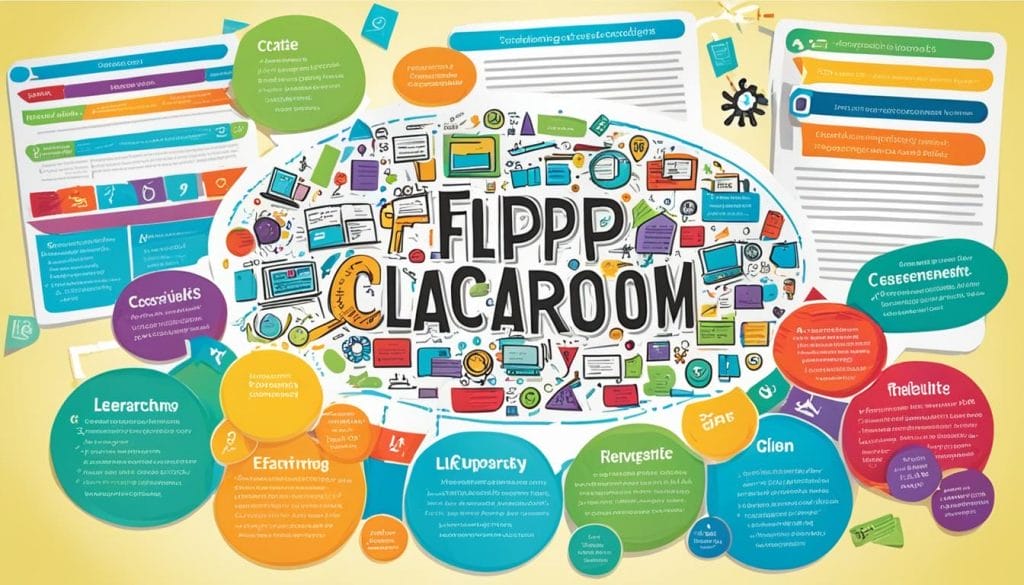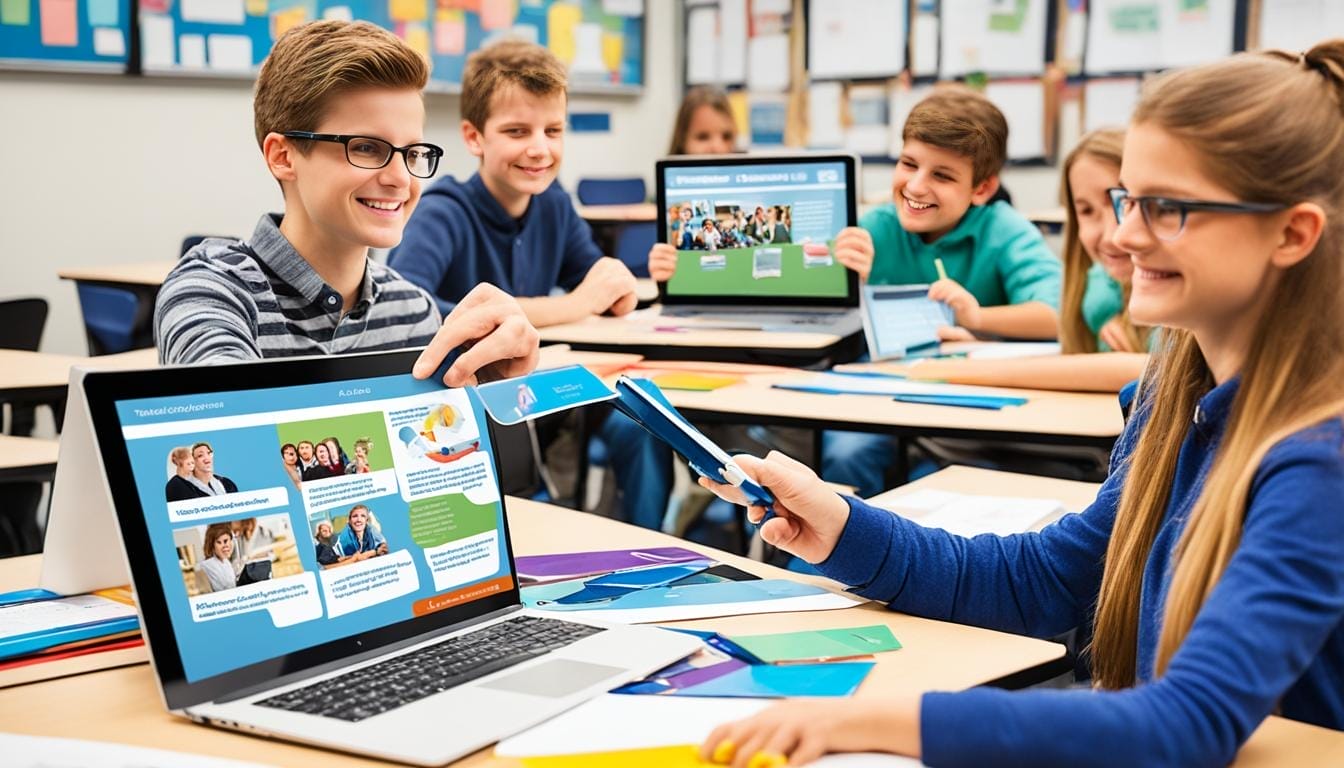Did you know that over 70% of educators who use a flipped classroom see more engaged students? This new way of teaching mixes fresh teaching methods with modern tech. It changes how we learn, making students more active in their education.
Instead of just listening in class, students watch videos or do activities at home. Then, they discuss and work on projects together in class. This method uses tools like Hyperspace to help teachers easily add new lessons to their classes.
Key Takeaways
- The flipped classroom increases student engagement significantly.
- Students access learning materials online, encouraging active participation.
- Blended learning approaches combine traditional and digital resources.
- Education technology facilitates effective classroom integration.
- Hyperspace provides vital support for educators in this model.
What is a Flipped Classroom?
The Flipped Classroom changes the old way of teaching. Students learn with online resources before class. This makes class time for doing things together, where they use what they learned.
Students watch videos and read materials on their own. This gets them ready for class. They’re set to join in discussions and work together.
This method lets students lead their learning. They learn the basics outside class and apply them in class. It builds a community where students work well together.
The Flipped Classroom meets different learning styles and needs. It boosts motivation and success in students. Active learning is key, making students independent and ready for success.
Understanding the Blended Learning Approach
The blended learning approach mixes traditional classroom learning with online learning. This creates a flexible way to learn. Students can learn at their own pace, fitting different learning styles and preferences.
Education technology is key in this method. Students use online tools to access materials and do homework from anywhere. Face-to-face classes focus on teamwork, making learning deeper. This mix makes learning flexible, letting students pick when to learn online or in class.
This mix of teaching methods makes learning richer. Teachers can use various methods to meet students’ needs. They can try new ways to teach, like flipping the classroom, which is part of blended learning. For more info, check out this helpful article.
| Characteristics | Blended Learning | Traditional Learning |
|---|---|---|
| Learning Flexibility | High | Low |
| Access to Resources | Online and In-Person | In-Person Only |
| Personalization | Tailored to Each Learner | One-Size-Fits-All |
Schools using blended learning offer a more personalized learning path. As technology gets better, learning can become even more effective. This opens up new chances for both students and teachers.
Flipped Classroom as a Blended Learning Approach
The Flipped Classroom is a new way of teaching that puts students in the lead. It makes learning more interactive and engaging. By using online tools, teachers can give out lessons before class. Then, class time is for group work and talking about what they learned.
Defining the Pedagogical Shift
This new way of teaching focuses on getting students more involved. In old teaching methods, teachers talk a lot in class. But in the Flipped Classroom, students learn on their own before class. This change helps students learn better.
Combining Online and In-Class Learning
Using online learning with in-class time makes learning more flexible. Students can watch lectures whenever they want. This frees up class time for hands-on activities. It makes learning more fun and lets students control their education. For more details, check out this detailed explanation on blended learning.
Advantages of a Flipped Classroom
The flipped classroom model brings many benefits for students and teachers. It helps students get more involved in their learning. They dive deeper into the material.
Enhanced Student Engagement
Students take charge of their learning by watching videos and reading online at home. This lets them learn at their own speed. Then, in class, they work together and share their thoughts.
This way, students get more from the class time. They feel more connected and in control of their learning.
Improved Learning Outcomes
Studies show that flipped classrooms can make students learn better. In class, they get to think deeply and get feedback from others. This makes them understand and remember more.
| Aspect | Traditional Classroom | Flipped Classroom |
|---|---|---|
| Student Engagement | Limited opportunities for active participation | Increased interaction and collaboration |
| Learning Pace | Uniform pacing for all students | Individualized learning at varied speeds |
| Feedback | Delayed feedback on assignments | Immediate feedback during class activities |
| Critical Thinking | Passive learning focus | Emphasis on problem-solving and analysis |
Active Learning in a Flipped Classroom
Active learning is key in the flipped classroom. It makes students more engaged with hands-on activities. These activities help students work together and share ideas to solve problems. This way, they understand tough topics better.
Encouraging Collaboration and Interaction
Working together changes how students learn. In a flipped classroom, groups talk about topics and use each other’s strengths. This helps them think better and communicate well, which is important for school and the job world.
Utilizing Technology for Enhanced Participation
Education technology makes active learning even better. Tools like video calls, online discussions, and project management keep students connected. These tools help teachers create fun, interactive lessons that everyone can join in.
| Aspect | Active Learning | Traditional Learning |
|---|---|---|
| Student Engagement | High due to collaboration and hands-on activities | Typically lower, with emphasis on lectures |
| Use of Technology | Extensive use of education technology to facilitate learning | Minimal technology integration |
| Collaboration | Promotes teamwork and peer interaction | Limited opportunities for collaboration |
| Learning Pace | Students set their own pace, fostering independence | Instructor-directed pace, less flexible |
Key Components of the Flipped Classroom Model

The flipped classroom model has several key parts that help improve student learning. One main part is using online resources that students can access easily. These include videos, readings, and other materials for learning at their own speed.
Another key part is structured classroom activities. Class time is set aside for group projects, discussions, and hands-on tasks. These activities help students use what they learned online. This method makes learning stronger and gets students more involved.
Teachers play a big role in a flipped classroom. They lead discussions and help students during the learning process. Teachers make sure students stay interested and focused on their goals. The flipped classroom’s focus on working together and sharing ideas creates a lively learning space.
Challenges of Implementing a Flipped Classroom
The flipped classroom model has big benefits for students and teachers. But, it also has challenges. Key areas to think about include teacher preparation and the tech needed for this new way of teaching.
Teacher Preparation and Support
Getting a flipped classroom to work well depends a lot on teacher prep. Teachers need to know how to make online materials that work well with what they do in class. They need both tech skills and new teaching methods.
It’s important to keep supporting teachers with training and new tools. This helps them feel confident and ready to use this new approach.
Necessary Technology Infrastructure
Having the right tech setup is another big challenge. Schools must make sure students can get online easily. They need good internet and devices to use online learning tools.
This tech setup is key for the flipped classroom to work well. It makes sure learning online and in class flows smoothly together.
Global Perspective: Flipped Classrooms in Different Educational Contexts
The flipped classroom model is getting more popular around the world. It lets students learn at their own pace with online content. This is especially helpful for those who are learning English as a second language. They can go back to lessons whenever they need to.
Success in International Classrooms
Teachers have seen great results with the flipped classroom in international settings. It uses technology to fit different learning styles and speeds. This way, students from various backgrounds can all take part and do well.
Students become more motivated and do better in school with this method. It shows how well it works in different cultures.
Adapting the Model for Diverse Learners
Education today focuses on including everyone. Teachers can change the flipped classroom to meet the needs of all students. They understand that everyone has their own background and way of learning.
This means making sure all students feel important. Teachers adjust the content and how they teach to make sure everyone gets a fair chance to learn.
| Educational Context | Outcome | Key Strategies |
|---|---|---|
| International Classrooms | Increased engagement and collaboration | Use of multilingual resources, peer support systems |
| Diverse Learners | Enhanced understanding and retention | Customized content delivery, varied assessments |
| Online Learning Environments | Improved flexibility in learning | Asynchronous access to materials, interactive tools |
Best Practices for Flipping Your Classroom

It’s key to follow best practices when flipping a classroom. The right strategies boost student engagement and learning. Making engaging online resources is the first step towards successful in-class activities.
Creating Effective Online Resources
Quality online resources are crucial in a flipped classroom. Teachers should make various materials for different learning styles. These can include:
- Instructional videos that break down complex topics
- Interactive quizzes that check understanding
- Online discussion boards for peer interaction
- Simulations or virtual labs for hands-on learning
When online resources match classroom goals, they help students understand better. They also prepare students for in-class activities.
Guiding Student Learning in Class
In-class time is crucial for applying online knowledge. Teachers should use different methods to help students learn, such as:
- Encouraging group work for sharing insights.
- Using formative assessments to check progress.
- Offering support to help individual students.
- Having feedback sessions to talk about learning.
By working closely with students and meeting their needs, teachers create a supportive learning environment. This boosts both academic success and student confidence.
| Best Practices | Description |
|---|---|
| Engaging Online Resources | Content that is visually appealing and interactive to capture student interests. |
| Active Learning Techniques | Methods that encourage participation and collaboration among students. |
| Regular Assessments | Tools for gauging understanding and offering timely feedback. |
| Flexible Teaching Strategies | Adjustment of methods based on student performance and needs. |
The Role of Teacher Facilitation in a Flipped Classroom
In a flipped classroom, teachers play a key role. They guide students instead of just teaching. This approach helps students use what they learn in real ways.
Transforming the Educator’s Role
Teachers change how they work in this new setup. They give support that fits each student’s needs. This helps students take charge of their learning.
It shows how important teachers are in making a supportive place for learning. They help students work together and learn from each other.
Fostering a Supportive Learning Environment
A supportive place is key for students to do well in a flipped classroom. Teachers use videos, activities, and focus on the student to make it engaging. These methods make students more interested and eager to learn more.
Teachers also offer feedback and chances for students to reflect. This helps build a culture of ongoing learning. For more on how to do this, check out an interesting article on designing effective e-learning courses.
Synchronous vs Asynchronous Learning in Flipped Classrooms
In flipped classrooms, it’s key to know the difference between synchronous and asynchronous learning. Both methods make learning more dynamic but for different reasons.
Understanding the Differences
Synchronous learning means students work together in real-time, either in person or online. It allows for quick feedback and teamwork. Examples include live chats, group tasks, and Q&A sessions.
Asynchronous learning lets students learn at their own speed. It uses pre-recorded lectures and assignments that students can do by themselves. This is great for those with busy schedules or different learning styles.
When to Use Each Approach
Synchronous learning is best for lively discussions or group projects that need real-time interaction. On the other hand, asynchronous learning suits topics that need deep thought or fits into a busy schedule.
Using both methods in flipped classrooms helps meet the needs of all students. Knowing when to use each approach makes learning more effective and tailored to each student.
| Learning Approach | Definition | Ideal Uses |
|---|---|---|
| Synchronous Learning | Real-time learning with immediate interaction | Live discussions, group activities, instant feedback |
| Asynchronous Learning | Flexible learning at one’s own pace | Recorded lectures, independent assignments |
Conclusion
The flipped classroom model is changing how we learn, making students more active in their education. It uses technology to create a focus on the student, improving engagement and learning results. Teachers can now design lessons that encourage critical thinking and teamwork.
Teachers have many tools and resources to help them use this method. For example, Hyperspace offers tools that fit today’s digital needs. This helps make sure every student gets the personalized education they need in our fast-changing world.
Adopting the flipped classroom is a big step towards updating education. It helps students connect with the knowledge they want and understand it better. By using adaptive learning technologies, teachers can make their lessons even better. They can use data to tailor their teaching to what each student needs. For more information, check out this link.
FAQ
What is a flipped classroom?
A flipped classroom is a new way to teach that changes the usual class setup. Students watch videos and do online work at home. Then, they use class time for group projects, discussions, and hands-on activities.
How does blended learning relate to flipped classrooms?
Blended learning mixes online and in-person learning. It lets schools meet different learning styles. The flipped classroom is a type of blended learning where students learn online first and then apply what they know in class.
What are the advantages of using a flipped classroom?
The flipped classroom makes learning more engaging by letting students take charge of their education. It helps them understand better through hands-on activities and working with peers in class.
How does technology support the flipped classroom model?
Technology is key in flipped classrooms. It offers online resources, helps with discussions, and makes learning active. Tools like virtual classrooms and online platforms make lessons interactive and promote teamwork.
What are some challenges faced when implementing a flipped classroom?
Teachers need to prepare well, create good online resources, and make sure students have the right technology. Schools must have strong internet and devices for students to use online content.
How do educators facilitate learning in a flipped classroom?
Teachers move from just lecturing to helping students apply what they know in class. They create a supportive space for teamwork, solving problems, and learning from each other.
Can the flipped classroom model be adapted for diverse learners?
Yes, the flipped classroom can be changed to fit different students. By offering online resources at various times, teachers can meet the needs of all students, including those who need to review material.
What is the difference between synchronous and asynchronous learning in flipped classrooms?
Synchronous learning happens live, allowing students to talk right away. Asynchronous learning lets students watch lectures whenever they want. Knowing when to use each type helps keep students interested and meets their learning styles.





